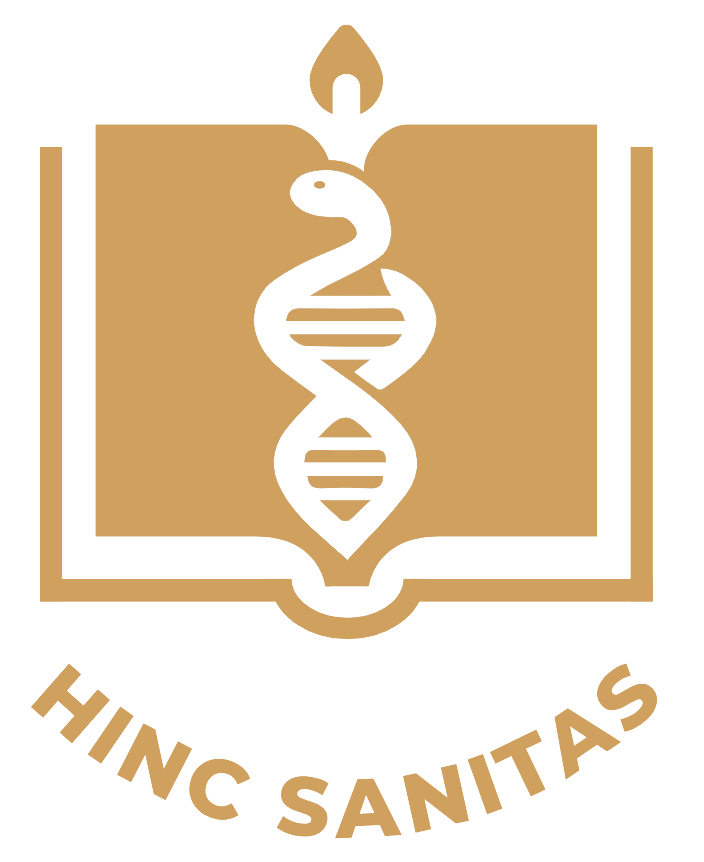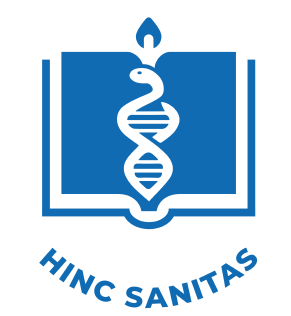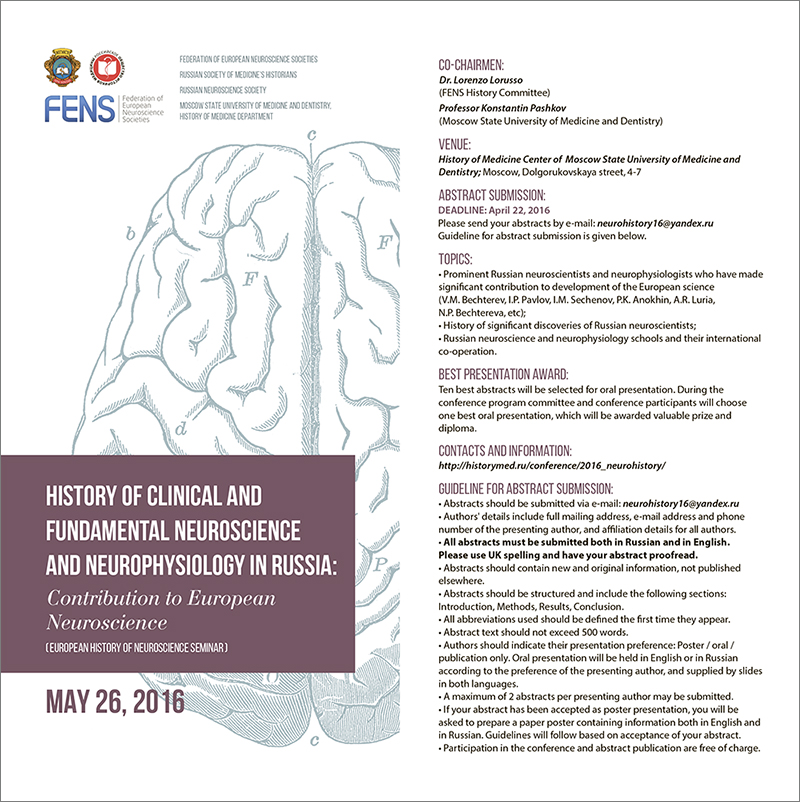ИСТОРИЯ МЕДИЦИНЫ

Проект кафедры истории медицины Российского университета медицины
Русский | English
|
FEDERATION OF EUROPEAN NEUROSCIENCE SOCIETIES |
|
|
RUSSIAN SOCIETY OF MEDICINE'S HISTORIANS | |
|
RUSSIAN NEUROSCIENCE SOCIETY | |
|
MOSCOW STATE UNIVERSITY OF MEDICINE AND DENTISTRY
| |
|
|
HISTORY OF CLINICAL AND FUNDAMENTAL NEUROPHYSIOLOGY IN RUSSIA:
CONTRIBUTION TO EUROPEAN NEUROSCIENCE
(European History of Neuroscience Seminar)
26 May 2016
|
Co-chairmen | Dr. Lorenzo Lorusso (FENS-History Committee)
Professor Konstantin Pashkov (Moscow State University of Medicine and Dentistry) |
|
Venue: |
Moscow, History of medicene center of Moscow State, University of medicine and dentisrty Dolgorukovskaya, house.4-7 |
|
Abstract submission: | Deadline: 30 April 2016
Please send your abstracts by email - Neurohistory16@yandex.ru Guideline for abstract submission is given below |
|
Topics: |
|
Best presentation award: Ten best abstracts will be selected for oral presentation. During the conference program committee and the conference participants will choose one best oral presentation, which will be awarded a valuable prize and a diploma.
Contacts and Information: http://historymed.ru/conference/2016_neurohistory/index_en.php
Programm, pdf
Guideline for abstract submission
- Abstracts should be submitted via e-mail Neurohistory16@yandex.ru.
- Authors' details include full mailing address, email address and phone number of the presenting author, and affiliation details for all authors.
- All abstracts must be submitted both in Russian and in English. Please use UK spelling and have your abstract proofread.
- Abstracts should contain new and original information, not published elsewhere.
- Abstracts should be structured and include the following sections: Introduction, Methods, Results, Conclusion.
- All abbreviations used should be defined the first time they appear.
- Abstract text should not exceed 500 words.
- Authors should indicate their presentation preference: Poster / oral / publication only. Oral presentation will be held in English or in Russian according to the preference of the presenting author, and supplied by slides in both languages.
- A maximum of 2 abstracts per presenting author may be submitted.
- If your abstract has been accepted as poster presentation, you will be asked to prepare a paper poster containing information both in English and in Russian. Guidelines will follow based on acceptance of your abstract.
- Participation in the conference and abstract publication is free of charge.
INVITED SPEAKERS
 |
Professor Dr. med. Axel Karenberg
STROKE: FROM ANCIENT GREECE TO THE 21ST CENTURY Clinical descriptions of strokes as well as speculations about etiology and treatment have occupied a prominent position throughout the history of Western medicine. Following a quick look at methodological issues, the talk will trace the development of the understanding of apoplectic syndromes as it has evolved in antiquity, Middle Ages, and Modern Times. The main message is: insights from the past will produce better physicians today – physicians who are able to put their own work into perspective.
|
 |
Professor Sergey Medvedev
SCHOOL OF N. P. BECHTEREVA
|
 |
Professor Dmitry Sakharov
UNDERSTANDING THE BRAIN AS A MULTINEUROTRANSMITTER SYSTEM: KH. S. KOSHTOYANTS AND HIS SCHOOL In the mid 1950s, the prominent Soviet physiologist Khachatur Sedrakovich Koshtoyants (1900-1961) put forward a hypothesis that processes in the nervous system are based on chemical mechanisms inherited from pre-nervous instruments of control and regulation. This view is an alternative to the old and still dominating approach, which describes the biological substrate of nervous activity in terms of electrical wiring diagram (e. g., the connectome concept). Here, some of the recent achievements of the Koshtoyants’ school are considered, as well as their impact on the world neuroscience. Special attention is given to the results that demonstrate independent origins of different neuron phenotypes, evolutionary conserved roles for individual neurotransmitter molecules, and participation of non-synaptic and multi-neurotransmitter mechanisms in the organization of neuronal ensembles, such as central pattern generators.
|
 |
Professor Boleslav Lichterman
THE MOSCOW COLLOQUIUM ON ELECTROENCEPHALOGRAPHY OF HIGHER NERVOUS ACTIVITY (1958) AND ITS IMPACT ON INTERNATIONAL BRAIN RESEARCH |
 |
Professor Vladimir Skrebitsky
HISTORY OF SYNAPTIC PLASTICITY STUDY. CONTRIBUTION OF RUSSIAN SCIENTISTS The study of synaptic plasticity have been laid by the work Bliss and Lomo (1973) weher they describe the long-term increase in the dentate gyrus neurons in response to a short high frequency stimulation of the perforant path fibers. This phenomenon is called long-term potentiation (LTP). It should be noted that in the same year in the laboratory of O. S. Vinogradova the similar phenomenon has been described (Vinogradova and Bragin, 1973). Later, in a series of experiments by L. L. Voronin many LTP properties were studied, showing the relationship of this phenomenon with the mechanisms of the conditioned reflex. The laboratory of V. G. Skrebitsky carried out intracellular LTP registration in hippocampal slices and showed that LTP is an adequate model for studying the mechanisms of action of various physiologically active substances used in neurology and psychiatry.
|
  |
Paevsky Alexey
Horughaya Anna
PROMOTING NEUROSCIENCE THROUGH HISTORY. EXPERIENCE OF BLOG AND NEWS MEDIA |






